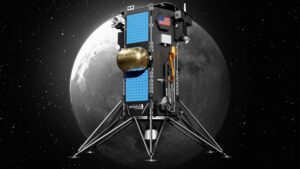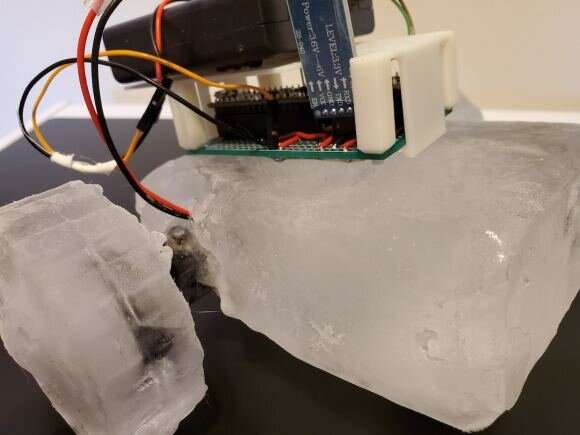Defense, Commerce departments join to find 5G solutions
Wednesday, 13 January 2021 06:00 The U.S. departments of Defense and Commerce will jointly seek public input on development of 5G communication networks, they announced on Monday.
5G, or fifth generation telecommunications standard for broadband cellular networks, offers higher download speeds and has been of particular interest to the U.S. military prior to its civilian rollout in 2019.
The Defense Department r
The U.S. departments of Defense and Commerce will jointly seek public input on development of 5G communication networks, they announced on Monday.
5G, or fifth generation telecommunications standard for broadband cellular networks, offers higher download speeds and has been of particular interest to the U.S. military prior to its civilian rollout in 2019.
The Defense Department r The earliest supermassive black hole and quasar in the universe
Wednesday, 13 January 2021 06:00 The most distant quasar known has been discovered. The quasar, seen just 670 million years after the Big Bang, is 1000 times more luminous than the Milky Way, and is powered by the earliest known supermassive black hole, which weighs in at more than 1.6 billion times the mass of the Sun.
Seen more than 13 billion years ago, this fully formed distant quasar is also the earliest yet discover
The most distant quasar known has been discovered. The quasar, seen just 670 million years after the Big Bang, is 1000 times more luminous than the Milky Way, and is powered by the earliest known supermassive black hole, which weighs in at more than 1.6 billion times the mass of the Sun.
Seen more than 13 billion years ago, this fully formed distant quasar is also the earliest yet discover 'Old Faithful' cosmic eruption shows black hole ripping at star
Wednesday, 13 January 2021 06:00 You've heard of Old Faithful, the Yellowstone National Park geyser that erupts every hour or two, a geological phenomenon on a nearly predictable schedule.
Now, an international group of scientists who study space have discovered an astronomical "Old Faithful" - an eruption of light flashing about once every 114 days on a nearly predictable schedule. The researchers believe it is a tidal d
You've heard of Old Faithful, the Yellowstone National Park geyser that erupts every hour or two, a geological phenomenon on a nearly predictable schedule.
Now, an international group of scientists who study space have discovered an astronomical "Old Faithful" - an eruption of light flashing about once every 114 days on a nearly predictable schedule. The researchers believe it is a tidal d Researchers use LRZ HPC resources to perform largest-ever supersonic turbulence simulation
Wednesday, 13 January 2021 06:00 Through the centuries, scientists and non-scientists alike have looked at the night sky and felt excitement, intrigue, and overwhelming mystery while pondering questions about how our universe came to be, and how humanity developed and thrived in this exact place and time. Early astronomers painstakingly studied stars' subtle movements in the night sky to try and determine how our planet moves i
Through the centuries, scientists and non-scientists alike have looked at the night sky and felt excitement, intrigue, and overwhelming mystery while pondering questions about how our universe came to be, and how humanity developed and thrived in this exact place and time. Early astronomers painstakingly studied stars' subtle movements in the night sky to try and determine how our planet moves i NASA missions help investigate an 'old faithful' active galaxy
Wednesday, 13 January 2021 06:00 During a typical year, over a million people visit Yellowstone National Park, where the Old Faithful geyser regularly blasts a jet of boiling water high in the air. Now, an international team of astronomers has discovered a cosmic equivalent, a distant galaxy that erupts roughly every 114 days.
Using data from facilities including NASA's Neil Gehrels Swift Observatory and Transiting Exopla
During a typical year, over a million people visit Yellowstone National Park, where the Old Faithful geyser regularly blasts a jet of boiling water high in the air. Now, an international team of astronomers has discovered a cosmic equivalent, a distant galaxy that erupts roughly every 114 days.
Using data from facilities including NASA's Neil Gehrels Swift Observatory and Transiting Exopla Galaxy mergers could limit star formation
Wednesday, 13 January 2021 06:00 Our astronomers have looked nine billion years into the past to find evidence that galaxy mergers in the early universe could shut down star formation and affect galaxy growth.
Using a powerful Earth-based telescope they saw that a huge amount of star-forming gas was ejected into the universe by the coming together of two galaxies.
The merger created a new galaxy called ID2299 at a t
Our astronomers have looked nine billion years into the past to find evidence that galaxy mergers in the early universe could shut down star formation and affect galaxy growth.
Using a powerful Earth-based telescope they saw that a huge amount of star-forming gas was ejected into the universe by the coming together of two galaxies.
The merger created a new galaxy called ID2299 at a t When Galaxies Collide: Hubble Showcases 6 Beautiful Galaxy Mergers
Wednesday, 13 January 2021 06:00 To celebrate a new year, the NASA/ESA Hubble Space Telescope has published a montage of six beautiful galaxy mergers. Each of these merging systems was studied as part of the recent HiPEEC survey to investigate the rate of new star formation within such systems. These interactions are a key aspect of galaxy evolution and are among the most spectacular events in the lifetime of a galaxy.
It
To celebrate a new year, the NASA/ESA Hubble Space Telescope has published a montage of six beautiful galaxy mergers. Each of these merging systems was studied as part of the recent HiPEEC survey to investigate the rate of new star formation within such systems. These interactions are a key aspect of galaxy evolution and are among the most spectacular events in the lifetime of a galaxy.
It Wind bands, jet streams spotted on nearest brown dwarf
Wednesday, 13 January 2021 06:00 The brown dwarf closest to our solar system hosts wind bands and jet streams, according to new analysis of the object's atmosphere.
Brown dwarfs are too big to be planets but not quite massive enough to generate fusion, a prerequisite for stellar classification. Though hot in their infancy, brown dwarfs steadily cool as they mature, making them difficult to spot and study.
Becaus
The brown dwarf closest to our solar system hosts wind bands and jet streams, according to new analysis of the object's atmosphere.
Brown dwarfs are too big to be planets but not quite massive enough to generate fusion, a prerequisite for stellar classification. Though hot in their infancy, brown dwarfs steadily cool as they mature, making them difficult to spot and study.
Becaus Chandra Studies Extraordinary Magnetar
Wednesday, 13 January 2021 06:00 In 2020, astronomers added a new member to an exclusive family of exotic objects with the discovery of a magnetar. New observations from NASA's Chandra X-ray Observatory help support the idea that it is also a pulsar, meaning it emits regular pulses of light.
Magnetars are a type of neutron star, an incredibly dense object mainly made up of tightly packed neutron, which forms from the coll
In 2020, astronomers added a new member to an exclusive family of exotic objects with the discovery of a magnetar. New observations from NASA's Chandra X-ray Observatory help support the idea that it is also a pulsar, meaning it emits regular pulses of light.
Magnetars are a type of neutron star, an incredibly dense object mainly made up of tightly packed neutron, which forms from the coll Unveiling the double origin of cosmic dust in the distant Universe
Wednesday, 13 January 2021 06:00 Two billion years after the Big Bang, the Universe was still very young. However, thousands of huge galaxies, rich in stars and dust, were already formed. An international study, led by SISSA - Scuola Internazionale Superiore di Studi Avanzati, now explains how this was possible.
Scientists combined observational and theoretical methods to identify the physical processes behind their evolu
Two billion years after the Big Bang, the Universe was still very young. However, thousands of huge galaxies, rich in stars and dust, were already formed. An international study, led by SISSA - Scuola Internazionale Superiore di Studi Avanzati, now explains how this was possible.
Scientists combined observational and theoretical methods to identify the physical processes behind their evolu SpaceX wins contracts for lunar lander, environmental satellite launches
Tuesday, 12 January 2021 23:55
WASHINGTON — SpaceX secured contracts Jan. 13 for the launches of a commercial lunar lander mission backed by NASA as well as a privately funded satellite to track methane emissions.
Intuitive Machines announced that it selected SpaceX for the launch of its IM-2 lunar lander mission on a Falcon 9 rocket no earlier than 2022.
Alabama’s Redstone Arsenal selected as future home of U.S. Space Command
Tuesday, 12 January 2021 19:42
WASHINGTON — The U.S. Army’s Redstone Arsenal in Huntsville, Alabama, was picked as the future location of U.S. Space Command’s headquarters.
Air Force Secretary Barbara Barrett announced the decision Jan. 13.
The selection of Redstone Arsenal is a huge win for Huntsville, nicknamed “Rocket City.
A robot made of ice could adapt and repair itself on other worlds
Tuesday, 12 January 2021 14:06
Some of the most tantalizing targets in space exploration are frozen ice worlds. Take Jupiter's moon Europa, for instance. Its warm, salty subsurface ocean is buried under a moon-wide sheet of ice. What's the best way to explore it?
Maybe an ice robot could play a role.
Though the world's space agencies—especially NASA—are getting better and better at building robots to explore places like Mars, those robots have limitations. Perhaps chief among those limitations is the possibility of breakdown. Once a rover on Mars—or somewhere even more distant—breaks down, it's game over. There's no feasible way to repair something like MSL Curiosity if it breaks down while exploring the Martian surface.
But what if the world being explored was a frozen one, and the robot was made of ice? Could icy robots perform self-repair, even in a limited fashion? Could they actually be manufactured and assembled there, even partly?
Director General’s annual press conference 2021
Tuesday, 12 January 2021 13:37
Join our start-of-year press conference with ESA Director General Jan Wörner and future Director General Josef Aschbacher plus other ESA Directors when they meet online on Thursday, 14 January 2021. The event starts at 09:30 GMT / 10:30 CET. Watch live on #ESAwebTV.
Blue Origin preparing for next New Shepard flight
Tuesday, 12 January 2021 12:30
WASHINGTON — Blue Origin is gearing up for the next test flight of its New Shepard suborbital vehicle as soon as Jan. 14.
Temporary flight restrictions published by the Federal Aviation Administration Jan. 12 will close airspace above Blue Origin’s West Texas test site from Jan.

